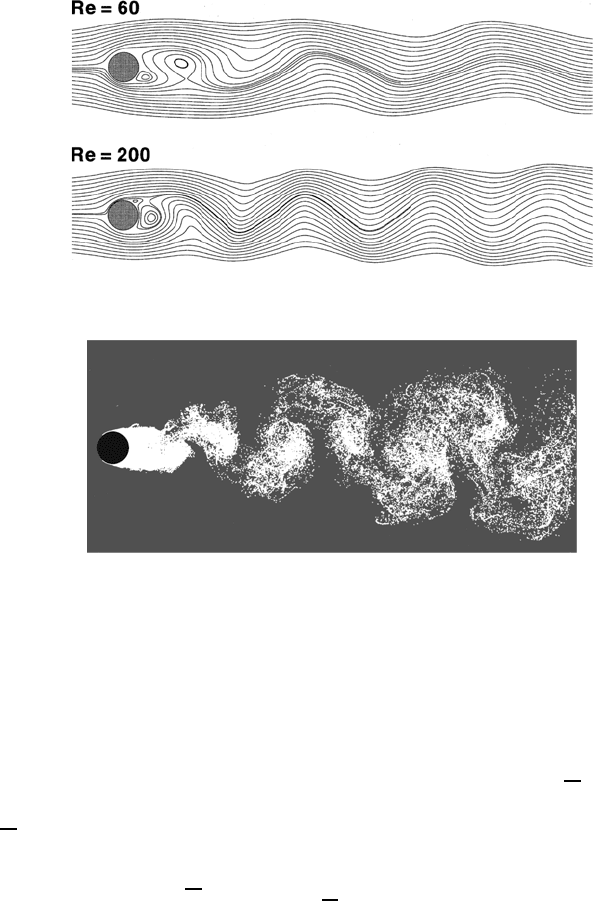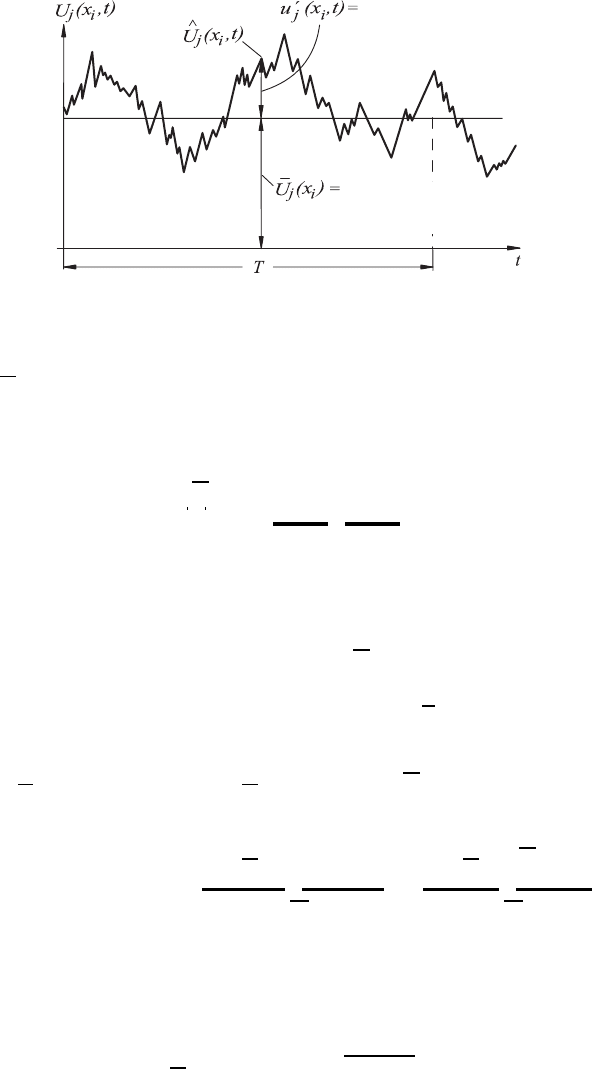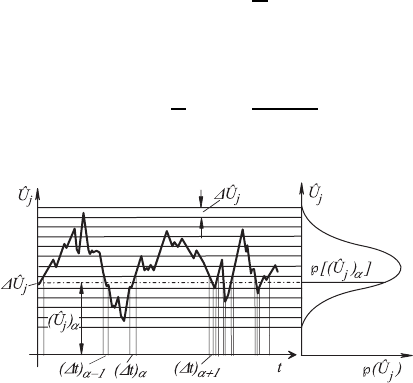Durst F. Fluid Mechanics: An Introduction to the Theory of Fluid Flows
Подождите немного. Документ загружается.

Chapter 18
Turbulent Flows
18.1 General Considerations
In Chap. 17, we pointed out that special flow properties exist to justify the
classification of fluid motions into laminar, transitional and turbulent flows.
As laminar were designated all flows which proved stable towards distur-
bances introduced from outside, resulting in flows with a high degree of order
and in which diffusion phenomena are characterized only by molecular diffu-
sion. Laminar flows can be dependent on time, as the Karman vortex street
shows, which is depicted in Fig. 18.1. As long as the flow shows the high de-
gree of order which is characteristic of it, it is laminar. This means that the
viscosity of the fluid is able, in stable laminar flows, to attenuate sufficiently
fluctuations of the flow properties that would otherwise disturb the orderli-
ness of the flow. Perturbation attenuations of this kind usually occur at low
Reynolds numbers of all flows.
When considering flows at high Reynolds numbers, one finds that flow
phenomena such as the Karman vortex street, visually perceivable thanks
to flow visualization techniques, lose their “regularity,” i.e. stochastic fluc-
tuations of all flow properties are observed, as indicated in Fig. 18.2. These
fluctuations occur superimposed on the mean flow characteristics.
The fluid motions, known to be of high regularity for laminar flows, do not
exist any longer as orderly in turbulent flows, i.e. in flows of high Reynolds
numbers. At high Reynolds numbers, a flow state exists which stands out for
its strong irregularity, in connection with an extremely high diffusivity which
can exceed the molecular-dependent transport processes by several orders of
magnitude. Connected with that is an increased intermixing of the fluid and
an increased transport rate of the momentum, and also increased heat and
mass transport. All these characteristics led to the introduction of the term
“turbulence” for the state of flows with this strongly irregular flow behavior,
in order to give a clear expression of the differing character compared with
laminar flows. These differences have to be considered also when treating
523

524 18 Turbulent Flows
Fig. 18.1 The Karman vortex street, at low Reynolds numbers a time-varying
laminar flow
Fig. 18.2 The Karman vortex street (at high Reynolds numbers) in a turbulent flow
turbulent flows theoretically, i.e. turbulent flows require a specific treatment
which differs from that of laminar flows.
On introducing into a turbulent flow field a velocity sensor which is capable
of measuring the local instantaneous velocity, such a measurement results in
a velocity dependence on time, as indicated in Fig. 18.3. At a point in space,
the signal is characterized by strong fluctuations of the flow velocity in time,
which can be stated as deviations u
j
(x
i
,t)fromameanvalueU
j
(x
i
), the
latter being a constant with respect to time. Here, the time mean value
U
j
(x
i
)isdefinedasfollows:
U
j
(x
i
) = lim
T →∞
1
T
#
T
0
ˆ
U
j
(x
i
,t)dt, (18.1)
where
ˆ
U
j
(x
i
,t) indicates the instantaneous value of the velocity (see Fig. 18.3)
and T is the integration time over which the indicated time-averaging takes
place.
Thus,
ˆ
U
j
(x
i
,t) can be taken as a quantity which allows one to consider
the local flow velocity, varying over time, as the sum of a quantity that is
constant with respect to time and a quantity that is fluctuating in time. This

18.1 General Considerations 525
Turbulent fluctuation
of the velocity
component of
U
j
Time averaged
velocity component of
U
j
Fig. 18.3 Time velocity path at a point x
i
within a turbulent flow field
decomposition of the instantaneous velocity
ˆ
U
j
(x
i
,t) into a time-averaged
part
U
j
(x
i
) and a fluctuating part u
j
(x
i
,t) has advantages, as will be shown
later. It was introduced by Reynolds to treat turbulent flows.
The above definition of the mean velocity states, for T →∞, an equality
in area:
T
U
i
rectangular
area
= lim
T →∞
#
T
0
ˆ
U
i
(t)dt
integral over
time-dependent signal
. (18.2)
When considering this definition of the time mean value of the velocity,
then for the quantity u
j
(x
i
,t), designated as turbulent velocity fluctuation,
the following equation holds:
u
j
(x
i
,t)=
ˆ
U
j
(x
i
,t) − U
j
(x
i
). (18.3)
When applying to this relationship the operator lim
T →∞
1
T
'
T
0
()dt, the following
can be carried out:
lim
T →∞
1
T
#
T
0
u
j
(x
i
,t)dt = lim
T →∞
1
T
#
T
0
ˆ
U
j
(x
i
,t) − U
0
(x
i
)
dt
= lim
T →∞
1
T
#
T
0
ˆ
U
j
(x
i
,t)dt
=U
j
− lim
T →∞
1
T
#
T
0
U
j
(x
i
)dt
=U
j
.
(18.4)
It can be concluded that the two integrals shown on the right-hand side of
(18.4) are equal and their difference yields 0, i.e. the following holds for the
time average of turbulent velocity fluctuations:
lim
T →∞
1
T
#
T
0
u
j
(x
i
,t)dt = u
j
(x
i
,t)=0, (18.5)

526 18 Turbulent Flows
where the overbar on u
j
(x
i
,t) represents a simplified way of writing the
carried out time averaging. On designating the turbulent velocity fluctuations
with u
j
(x
i
,t) (or simplifying this to u
j
), then the following can be said:
• The time average of the turbulent velocity fluctuations u
j
is equal to zero
per definition. Hence, there is a way to present turbulence in local, time-
varying quantities, in a form such that the turbulent fluctuations of all
flow quantities, that are introduced into the considerations, show a time
mean value that is zero.
For the fluctuating velocity quantity u
j
, moments of higher order can also be
defined:
u
n
j
= lim
T →∞
1
T
#
T
0
u
n
j
dt, (18.6)
which in general show values different from zero. Especially for the rms value
of the turbulent velocity fluctuations, the following holds:
σ
i
=
u
2
i
=
$
lim
T →∞
1
T
#
T
0
u
2
i
dt. (18.7)
This can be employed for the definition of the turbulence intensity:
Tu=
1
2
u
i
u
i
U
tot
=
0
1
2
u
2
1
+ u
2
2
+ u
2
3
U
tot
. (18.8)
This quantity represents a measure of the intensity of the turbulent fluctua-
tions of the velocity components with respect to the local mean value
U
tot
.
As shown in (18.8), it is often usual to take as a relative value the mean
value of the total velocity vector, i.e.
U
tot
=
U
j
U
j
.TheTu-value is often
only around a few percent for some flows and, because of this, one speaks of
a turbulent flow of low intensity. When the value is around 10% and more,
the flow is defined as highly turbulent. Highly turbulent flows occur mostly
in industrial flow systems. It is the task of fluid mechanics to develop and
bring to application measurement techniques and numerical solution methods
which allow investigations of turbulent flows with low and high turbulence
intensities. In practice, it is often sufficient to only have information on time
mean values of turbulent quantities of an investigated flow field.
The introductory explanations above indicate clearly that turbulent flow
fields show a complex behavior, providing strong property variations in space
and time, so that detailed considerations are only worth the effort if spe-
cial insights into the physics of turbulence are needed. For practical flow
considerations, it is sufficient to treat turbulent flow processes by means of
their statistical mean properties, i.e. to describe the most important char-
acteristics of turbulent flows by statistical mean values. In this chapter, the
18.2 Statistical Description of Turbulent Flows 527
most important methods of statistical flow considerations are summarized
and explained briefly, in order to employ them subsequently in the treatment
of turbulent flows. More details are found in refs. [18.4] to [18.9].
18.2 Statistical Description of Turbulent Flows
As emphasized in Sect. 18.1, turbulent velocity fields are characterized by
strong irregularities of all their properties, e.g. strong changes of their ve-
locity and pressure in space and time. To register them, at all times and
at all locations, is not only a task which is difficult to solve and that
exceeds our present measuring and representation capacities of fluid me-
chanical processes, but moreover constitutes a task whose solution is not
worth striving for. The solution would result in such a large amount of
information that it could not be possible to process them further, or to
exploit them, in order to gain new insights into fluid mechanical pro-
cesses. The large amount of information which turbulent flows possess due
to their time and space behavior, therefore does not serve to deepen our
fluid mechanical knowledge, nor does it help to improve fluid-flow equip-
ment and/or its installation. As fluid-flow information is only useful to the
extent to which it can be mentally grasped and exploited further, it is nec-
essary to reduce appropriately the large amount of information available
in turbulent flow fields. In today’s turbulent flow research, this is done by
mainly limiting investigations to two types of questions relating to turbulent
flows:
• How do the local turbulent fluctuations of the velocity components and
pressure vary around the corresponding mean values? What correlations
exist between the fluctuating quantities, and what physical significance do
these correlations have?
• How are neighboring turbulent fluctuations of the velocity components
and pressure correlated with one another, and what physical significance
do these correlations have?
To be able to give answers to these questions, one uses in turbulence re-
search methods of statistics and nearly all the terminology related to it.
The distribution of the local turbulent flow fluctuations and the turbulent
pressure fluctuations are recorded by the probability density distribution
℘(u
j
)or℘(p
), or by their Fourier transforms, the so-called characteris-
tic function ϕ(k). In order to describe the existing correlation between
neighboring points in terms of space and/or time, one uses appropriate
correlation functions or their Fourier transforms. To describe the locally
occurring fluctuations in time, the auto-correlation function of the fluctu-
ations is used and its Fourier transforms, or their corresponding energy
spectrum. All these quantities (probability density distribution, character-
istic function, auto-correlation function, energy spectrum, etc.) result from

528 18 Turbulent Flows
the instantaneous values of the velocity components and pressure describ-
ing the turbulent flow field, by applying mathematical operators which are
explained this chapter in a somewhat summarizing way. It is very impor-
tant for the further comprehension of the description of the characteristics
of turbulent flows to understand the employment of these operators and to
realize their physical significance. Further details are provided in refs. [18.1],
[18.3].
18.3 Basics of Statistical Considerations
of Turbulent Flows
18.3.1 Fundamental Rules of Time Averaging
For the treatment of turbulent flows, a method of consideration was intro-
duced by Reynolds (1895), where the instantaneous values of the velocity
components, pressure, density, temperature, etc., are replaced by mean values
(which are defined as constant in terms of time) to which the corresponding
time-varying, turbulent, fluctuating quantities, deviating from the mean val-
ues, are additively superimposed. Consequently, the instantaneous values can
be written as follows:
Velocity components
ˆ
U
j
(x
i
,t)=U
j
(x
i
)+u
j
(x
i
,t), (18.9)
Pressure
ˆ
P (x
i
,t)=P (x
i
)+p
(x
i
,t), (18.10)
Temperature
ˆ
T (x
i
,t)=T (x
i
)+t
(x
i
,t), (18.11)
Density ˆρ(x
i
,t)=ρ(x
i
)+ρ
(x
i
,t). (18.12)
The above quantities with overbars on them are the time-averaged values
and the quantities with a “hat,”
∧
, are the corresponding instantaneous
values. The values with primes,
, represent the turbulent fluctuations.
When applying the time-averaging operator:
lim
T →∞
1
T
T
#
0
(···)dt (18.13)
to the instantaneous values of the above quantities, one obtains the time mean
values, and this makes clear that the averaging in time over the turbulent
fluctuations of the quantities has the value 0. This means that the following
holds:
lim
T →∞
1
T
T
#
0
u
j
(x
i
,t)dt = 0 and lim
T →∞
1
T
T
#
0
p
(x
i
,t)dt = 0 (18.14)

18.3 Statistical Considerations 529
and further for the temperature fluctuations t
and the density fluctuations
ρ
:
lim
T →∞
1
T
T
#
0
t
(x
i
,t)dt = 0 and lim
T →∞
1
T
T
#
0
ρ
(x
i
,t)dt =0. (18.15)
Generally, we can therefore write:
lim
T →∞
1
T
T
#
0
α
(x
i
,t)dt =0, (18.16)
where α
(x
i
,t) stands for any randomly varying turbulent flow property.
When applying time averaging to derivatives of the quantity ˆα =
a + α
,
the following can be shown to be valid:
∂ ˆα
∂x
i
= lim
T →∞
1
T
T
#
0
∂ ˆα
∂x
i
dt =
∂
∂x
i
⎡
⎣
lim
T →∞
1
T
T
#
0
(α + α
)dt
⎤
⎦
=
∂
α
∂x
i
. (18.17)
Furthermore, the following fundamental rules of time averaging can be stated:
(ˆα +
ˆ
β)=¯α +
¯
β, (18.18)
¯αα
=0 and ˆαα
= α
2
, (18.19)
¯α
¯
β =¯α
¯
β and ˆα
ˆ
β =¯α
¯
β + α
β
. (18.20)
With the help and the consequent application of the integration rules, stated
above for the time averaging procedure, further relationships can be derived
for combinations of the functions ˆα(t)and
ˆ
β(t).
When applying to the product of the instantaneous functions ˆα(t),
ˆ
β(t)
and ˆγ(t) the time averaging rules above, the following relationship results:
ˆα
ˆ
βˆγ = (¯α + α
)(
¯
β + β
)(¯γ + γ
)=(¯α
¯
β + α
¯
β + β
¯α + α
β
)(¯γ + γ
)
=
¯α
¯
β¯γ + α
¯
β¯γ + β
¯α¯γ + α
β
¯γ +¯α
¯
βγ
+ α
¯
βγ
+ β
¯αγ
+ α
β
γ
=¯α
¯
β¯γ + α
β
¯γ + α
γ
¯
β +
β
γ
¯α + α
β
γ
.
(18.21)
In this way, triple products of the mean values of ˆα,
ˆ
β and ˆγ are obtained,
products of correlations of two quantities multiplied by the mean value of the
third quantity, and triple correlations of the turbulent fluctuation quantities
α
, β
and γ
result.
The above time averaging rules are employed in the subsequent sections,
in order to derive equations for the mean values from the basic equations

530 18 Turbulent Flows
of fluid mechanics. The latter are usually formulated for the instantaneous
values of the velocity, pressure, etc. In all the derivations in this chap-
ter, the fluid properties are assumed to be constant, and especially ρ =
constant. The resultant equations derived in this way indicate the mean
volume change by the time-averaged continuity equation, the mean mo-
mentum transport by the time-averaged momentum equation and the mean
energy transport by the time-averaged energy equation. On subtracting these
equations from the equations for the corresponding instantaneous values, one
obtains transport equations for the fluctuating quantities. The latter can be
employed for gaining information on these properties of turbulent flows.
18.3.2 Fundamental Rules for Probability Density
For the introduction of the probability density function for the velocity
components
ˆ
U
j
(x
i
,t), the velocity axis in Fig. 18.4 is subdivided into equal
sections ∆
ˆ
U
j
. The velocity distribution is plotted along the time axis, as
obtained at a fixed x
i
measuring location in a turbulent flow field. For the
considerations carried out here, the velocity distribution over time can be
assumed to be given for each velocity component
ˆ
U
j
(j =1, 2, 3). The hori-
zontal lines of the subdivision of the
ˆ
U
j
axis now lead for each velocity interval
∆U
j
to a corresponding period of time (∆t)
α
= f[(
ˆ
U
j
)
α
,∆U
j
]. This time in-
terval indicates how long the velocity trace stays in the corresponding time
interval. On summarizing all time intervals which are assigned to the same
velocity interval, the probability density function can be defined as follows:
lim
∆
ˆ
U
j
→0
℘
ˆ
U
j
α
∆
ˆ
U
j
α
= lim
T →∞
1
T
lim
N→∞
N
α=1
(∆t)
α
(18.22)
or rewritten:
℘
ˆ
U
j
α
= lim
T →∞
1
T
lim
∆U
j
→0
1
(∆
ˆ
U
j
)
α
N
α=1
(∆t)
α
. (18.23)
Fig. 18.4 Time path of the velocity and resultant probability density distribution

18.3 Statistical Considerations 531
The probability density distribution defined in this way contains all the
required information that indicates in which amplitude range the velocity
moves in time at a given measuring location. It indicates, moreover, with
which probability the amplitude of the fluctuating velocity components oc-
cur in the course of time. The resultant function is also shown in Fig. 18.4,
as a distribution function, which is plotted along the
ˆ
U
j
axis. It describes, in
a time-averaged way, the amplitude of the velocity fluctuations occurring at a
point in the turbulent flow. The computation of time-averaged values can thus
also take place through the corresponding probability density distribution,
as the entire amplitude distribution for the turbulent velocity fluctuations is
recorded in it.
For the mean value of the velocity, discussed in Sect. 18.1:
U
j,(x
i
)
= lim
T →∞
1
T
T
#
0
ˆ
U
j
(x
i
,t)dt (18.24)
the time-related increment dt can be written as
dt
T
= ℘
ˆ
U
j
d
ˆ
U
j
. (18.25)
For the integral
+∞
'
−∞
℘
ˆ
U
j
d
ˆ
U
j
, one can therefore derive from (18.25):
+∞
#
−∞
℘
ˆ
U
j
d
ˆ
U
j
=
1
T
T
#
0
dt =1, (18.26)
i.e. the “area” below the probability density distribution has the value 1.
The computation of the mean value of the local instantaneous flow velocity
ˆ
U
j
(x
i
,t), as given in (18.25), can be computed with the help of the probability
density function. This means that two possibilities exist for computing the
mean value, computation in the time domain or in the probability density
domain:
U
j
(x
i
) = lim
T →∞
1
T
T
#
0
ˆ
U
j
(x
i
)(t)dt =
+∞
#
−∞
℘(
ˆ
U
j
)
ˆ
U
j
d
ˆ
U
j
. (18.27)
Here, ℘(
ˆ
U
j
) is to be considered as being given for a fixed location x
i
.
ˆ
U
j
=
ˆ
U
j
(x
i
,t) represents the instantaneous value of the jth velocity component.
It is usual in turbulence research to state the probability density distribu-
tion only for the turbulent fluctuations, i.e. ℘(u
j
). This probability density
distribution arises from the distribution shown in Fig. 18.4 by a parallel dis-
placement of the ordinate axis by the amount of the mean velocity
U
j
.With
this parallel displacement the form of the probability density function does

532 18 Turbulent Flows
not change and it thus provides, in this new coordinate system, the amplitude
values of the turbulent fluctuations only.
Analogous to the time mean value computation with (18.27), one can
also compute the following moments of the velocity fluctuations. On the one
hand, computations can be carried out in the time domain of the velocity and,
on the other hand, in the probability density domain. Both methods yield
the time-averaged properties for the nth moment of the turbulent velocity
fluctuations:
(u
j
)
n
= lim
T →∞
1
T
T
#
0
7
u
j
(t)
8
n
dt =
+∞
#
−∞
℘(u
j
)(u
j
)
n
du
j
. (18.28)
Of special importance in turbulence research is the second moment
u
2
j
,which
is employed for the definition of the turbulence intensity, α =1, 2, 3:
Tu
α
=
σ
α
U
α
=
u
2
α
U
α
or Tu
j
=
σ
j
U
j
=
u
2
j
U
j
. (18.29)
Moreover, the “standardized third moment” of the turbulent velocity fluctu-
ations is included in several considerations, which allows statements about
the “skewness” of the probability density distribution of the turbulent veloc-
ity fluctuations. Here, the “skewness” is defined in the following way as the
standardized value of the turbulent velocity fluctuations:
S
j
=
u
3
j
σ
3
j
with σ
3
j
=
u
2
j
3
. (18.30)
For the corresponding standardized fourth moment, one often finds the term
“flatness” used in the literature. It represents another important property of
the probability density distribution of turbulent velocity fluctuations. As for
the skewness above, the flatness is again defined as a standardized quantity
(kurtosis):
F
j
=
u
4
j
σ
4
j
with σ
4
j
=
u
2
j
4
. (18.31)
The above moments of higher order for the velocity fluctuations are de-
fined as central moments of the probability density distributions of the
corresponding components of the turbulent velocity field.
In turbulence research, it is often necessary to define correlations between
the different velocity fluctuations. They are computed from the different time-
varying velocity fluctuations u
i
and u
j
as time integration over the products
of the fluctuations, according to the equation below. They can also be com-
puted, in a corresponding way, using the two-dimensional probability density
distributions.
